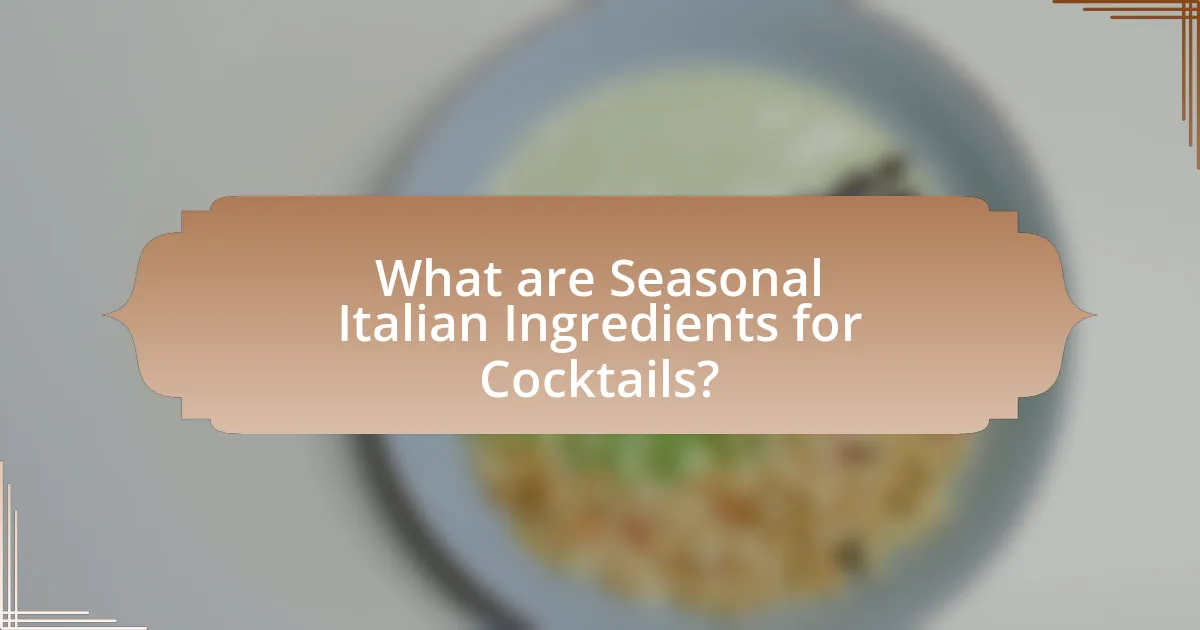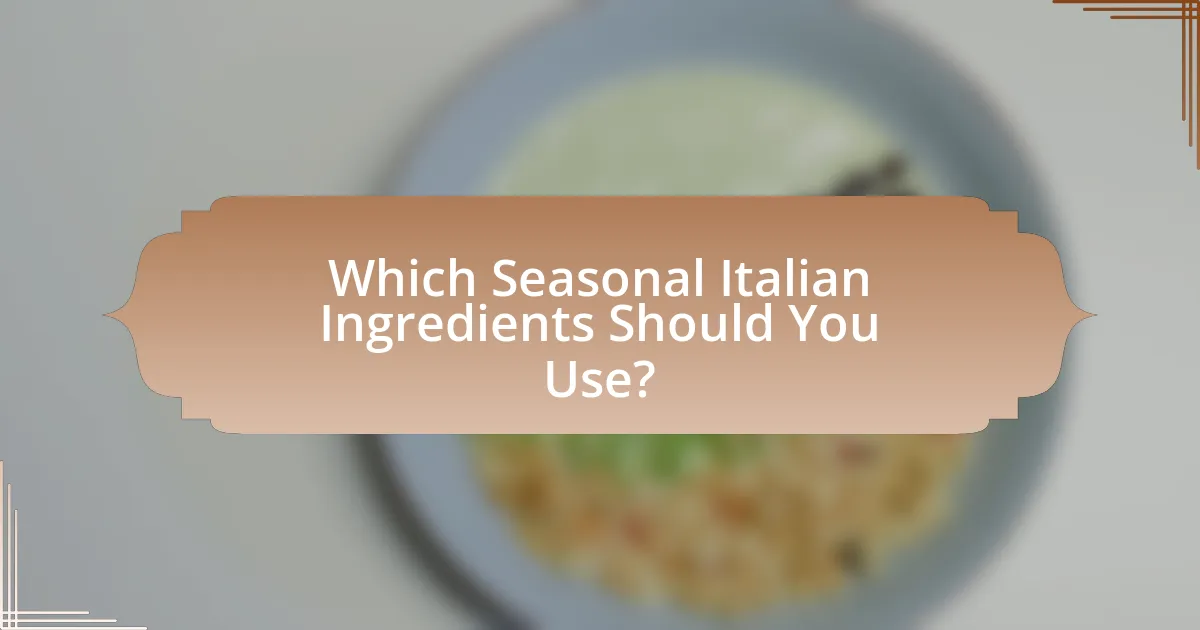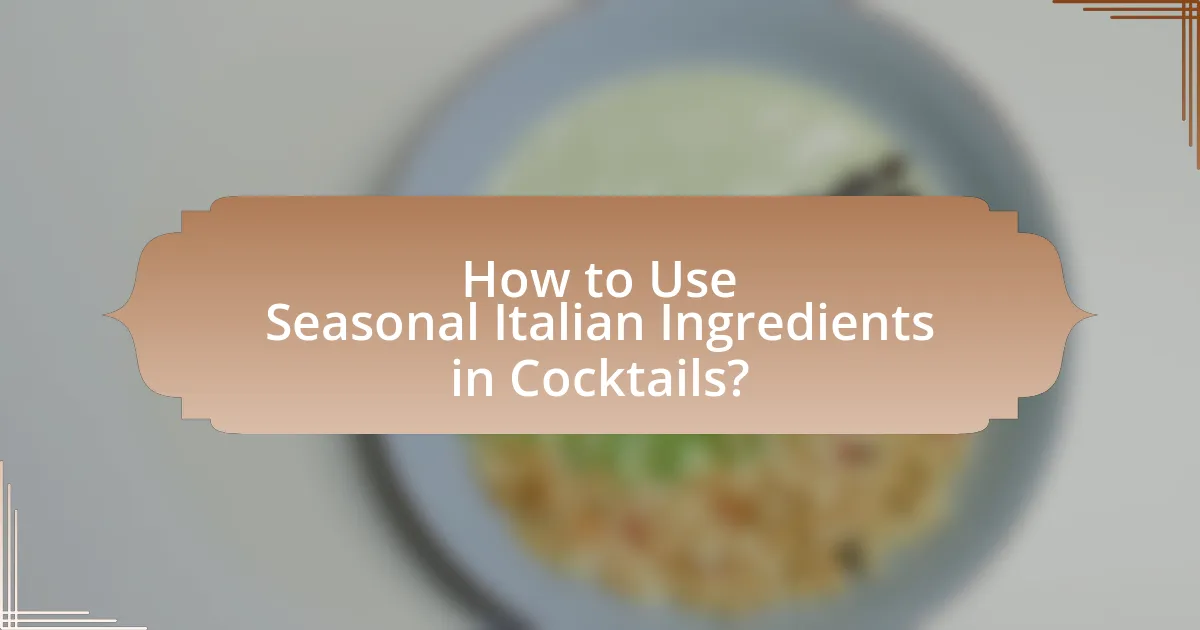The article focuses on the use of seasonal Italian ingredients to enhance cocktail preparation, emphasizing the importance of fresh herbs, fruits, and vegetables that vary by season. It details how these ingredients improve flavor profiles, reflect regional culinary traditions, and promote sustainability. Key seasonal ingredients are highlighted for each season, along with techniques for incorporating them into cocktails, such as infusion and muddling. The article also discusses the benefits of sourcing local produce and offers practical tips for crafting cocktails that celebrate the essence of Italian cuisine throughout the year.

What are Seasonal Italian Ingredients for Cocktails?
Seasonal Italian ingredients for cocktails include fresh herbs, fruits, and vegetables that vary by season. For example, in spring, ingredients like basil, mint, and strawberries are popular, while summer features ingredients such as peaches, tomatoes, and watermelon. Autumn brings figs, pears, and apples, and winter highlights citrus fruits like blood oranges and lemons. These ingredients not only enhance flavor but also reflect the regional diversity of Italian cuisine, making cocktails vibrant and seasonally relevant.
How do seasonal ingredients enhance cocktail flavors?
Seasonal ingredients enhance cocktail flavors by providing freshness and unique taste profiles that reflect the time of year. For instance, using ripe summer fruits like peaches or berries introduces vibrant sweetness and acidity, while winter herbs such as rosemary or thyme add depth and warmth. Research indicates that seasonal produce often contains higher levels of nutrients and flavor compounds, which can significantly elevate the overall sensory experience of a cocktail. This connection to the seasons not only improves taste but also creates a more authentic and engaging drinking experience, as consumers appreciate the use of locally sourced and in-season ingredients.
What are the key characteristics of seasonal ingredients?
Seasonal ingredients are characterized by their peak freshness, availability, and flavor during specific times of the year. These ingredients are often harvested at their optimal ripeness, which enhances their taste and nutritional value. For example, tomatoes are at their best in summer, providing a rich flavor that is less pronounced in off-season varieties. Additionally, seasonal ingredients tend to be more sustainable, as they require less energy for transportation and storage, aligning with local agricultural cycles. This connection to local farming practices not only supports the economy but also reduces the carbon footprint associated with food production.
How do seasonal ingredients reflect Italian culinary traditions?
Seasonal ingredients are integral to Italian culinary traditions as they emphasize freshness, regionality, and the celebration of local produce. This approach is rooted in the Italian philosophy of “cucina povera,” which utilizes what is available during specific times of the year, ensuring that dishes are made with the best quality ingredients. For example, tomatoes are at their peak in summer, leading to their prominent use in sauces and salads, while winter brings hearty vegetables like kale and root vegetables, which are featured in rustic soups and stews. This seasonal focus not only enhances flavor but also fosters a connection to the land and local farming practices, reflecting Italy’s diverse agricultural heritage.
Why choose Italian ingredients for cocktails?
Choosing Italian ingredients for cocktails enhances flavor and authenticity. Italian ingredients, such as vermouth, amaro, and fresh herbs, are renowned for their quality and unique profiles, which can elevate the overall cocktail experience. For instance, Italian vermouth is often crafted using a blend of high-quality wines and botanicals, providing a complex flavor that is difficult to replicate with non-Italian alternatives. Additionally, the use of fresh Italian herbs like basil and rosemary can add aromatic depth, making cocktails more vibrant and appealing. The emphasis on fresh, seasonal produce in Italy also ensures that ingredients are at their peak flavor, contributing to a superior cocktail.
What unique flavors do Italian ingredients bring to cocktails?
Italian ingredients bring a diverse range of unique flavors to cocktails, characterized by their freshness, aromatic qualities, and regional specificity. Ingredients such as limoncello provide a bright citrus note, while vermouth adds herbal complexity and depth. Additionally, Italian bitters like Aperol and Campari introduce a balance of sweetness and bitterness, enhancing the overall flavor profile of cocktails. The use of fresh herbs like basil and rosemary, common in Italian cuisine, contributes aromatic freshness that elevates the drinking experience. These ingredients are rooted in Italy’s rich culinary tradition, which emphasizes quality and seasonal produce, making them ideal for crafting sophisticated cocktails.
How do Italian ingredients pair with classic cocktail recipes?
Italian ingredients enhance classic cocktail recipes by introducing unique flavors and aromas that complement traditional spirits. For instance, using Italian vermouth in a Negroni adds herbal complexity, while fresh basil or rosemary can elevate a gin and tonic with aromatic freshness. Additionally, Italian liqueurs like Amaretto or Limoncello can provide a sweet and citrusy balance in cocktails such as the Amaretto Sour or Limoncello Spritz. The use of high-quality Italian olive oil in savory cocktails can also add a rich mouthfeel and depth, showcasing the versatility of these ingredients in mixology.

Which Seasonal Italian Ingredients Should You Use?
Seasonal Italian ingredients to use include fresh citrus fruits like blood oranges in winter, artichokes in spring, tomatoes in summer, and pumpkins in fall. These ingredients enhance cocktails by providing vibrant flavors and aromas that reflect the seasons. For example, blood oranges are known for their unique sweetness and color, making them ideal for winter cocktails, while ripe summer tomatoes can add a savory depth to drinks. Each ingredient not only contributes to the taste but also aligns with traditional Italian culinary practices that emphasize seasonal produce.
What are the best spring ingredients for cocktails?
The best spring ingredients for cocktails include fresh herbs like basil and mint, seasonal fruits such as strawberries and rhubarb, and floral elements like elderflower. These ingredients enhance cocktails with vibrant flavors and aromas that are characteristic of spring. For instance, basil and mint provide refreshing notes, while strawberries and rhubarb add sweetness and tartness, respectively. Elderflower liqueur is often used to impart a delicate floral essence, making it a popular choice in spring cocktails. These ingredients not only elevate the taste but also contribute to the visual appeal of the drinks, aligning with the seasonal theme of renewal and freshness.
How can you incorporate fresh herbs like basil and mint?
To incorporate fresh herbs like basil and mint into cocktails, muddle the herbs with other ingredients to release their essential oils and flavors. Muddling enhances the aromatic profile of cocktails, making them more refreshing and vibrant. For example, a classic Mojito uses mint, while a Basil Gimlet features basil, showcasing how these herbs can elevate the drink’s taste. Studies in mixology highlight that fresh herbs can significantly enhance the sensory experience of cocktails, making them more appealing to consumers.
What fruits are in season during spring in Italy?
During spring in Italy, fruits such as strawberries, cherries, apricots, and lemons are in season. These fruits are typically harvested from March to June, providing fresh and vibrant flavors ideal for enhancing cocktails. For instance, strawberries are known for their sweetness and are commonly used in various Italian cocktails, while lemons add a refreshing zest. The availability of these fruits during spring supports local agriculture and contributes to the seasonal culinary culture in Italy.
What seasonal ingredients are ideal for summer cocktails?
Seasonal ingredients ideal for summer cocktails include fresh fruits like peaches, berries, and citrus, as well as herbs such as basil and mint. These ingredients enhance flavor and provide refreshing qualities, making them perfect for warm weather drinks. For example, peaches add sweetness and a juicy texture, while citrus fruits like lemons and limes contribute acidity and brightness, essential for balancing cocktails. Additionally, herbs like basil and mint offer aromatic freshness, elevating the overall drinking experience.
How do citrus fruits enhance summer cocktails?
Citrus fruits enhance summer cocktails by adding vibrant flavors, acidity, and freshness. The natural acidity of citrus, such as lemons, limes, and oranges, balances sweetness in cocktails, creating a more harmonious taste profile. For instance, a classic summer cocktail like a Mojito benefits from lime juice, which brightens the drink and complements the mint. Additionally, citrus fruits provide essential vitamins, particularly vitamin C, which can boost the nutritional value of cocktails. The use of fresh citrus also contributes to the visual appeal of drinks, making them more inviting.
What are the benefits of using summer berries in drinks?
Using summer berries in drinks enhances flavor, adds nutritional value, and provides visual appeal. Summer berries, such as strawberries, blueberries, and raspberries, are rich in vitamins, antioxidants, and dietary fiber, which contribute to overall health. For instance, strawberries contain high levels of vitamin C and antioxidants like ellagic acid, which can help reduce inflammation and support heart health. Additionally, the vibrant colors of summer berries make drinks more visually enticing, increasing their attractiveness and appeal to consumers.
Which ingredients shine in autumn cocktails?
Autumn cocktails prominently feature ingredients such as apple cider, pumpkin puree, and spiced rum. These ingredients are celebrated for their ability to evoke the flavors and aromas of the season. Apple cider provides a crisp, refreshing base, while pumpkin puree adds a rich, creamy texture and a hint of sweetness. Spiced rum introduces warm, aromatic notes that complement the other flavors, making these ingredients ideal for creating comforting and festive drinks during the autumn months.
How can you use apples and pears in cocktail recipes?
Apples and pears can be used in cocktail recipes by incorporating their juices, purees, or fresh slices to enhance flavor and texture. For instance, apple juice can serve as a base for cocktails like the Apple Martini, while pear puree can be mixed into drinks such as a Pear Bellini. Additionally, fresh apple or pear slices can be used as garnishes, adding visual appeal and a hint of natural sweetness. The versatility of these fruits allows them to complement various spirits, including vodka, gin, and whiskey, making them ideal for seasonal cocktails.
What spices are commonly used in autumn Italian cocktails?
Common spices used in autumn Italian cocktails include cinnamon, nutmeg, and clove. These spices are often incorporated to enhance the warm, comforting flavors associated with the season. For instance, cinnamon adds a sweet and spicy note, while nutmeg contributes a rich, nutty flavor, and clove introduces a warm, aromatic quality. These spices are traditionally used in various Italian recipes and cocktails, reflecting the seasonal ingredients that elevate the overall drinking experience.
What winter ingredients can elevate your cocktails?
Winter ingredients that can elevate your cocktails include citrus fruits, spices, and herbal infusions. Citrus fruits like blood oranges and grapefruits add vibrant flavors and acidity, enhancing the overall taste profile of cocktails. Spices such as cinnamon, nutmeg, and cloves introduce warmth and complexity, making drinks more inviting during colder months. Additionally, herbal infusions using rosemary or thyme can provide aromatic depth, complementing the other flavors. These ingredients not only enhance the sensory experience but also align with seasonal availability, ensuring freshness and quality in cocktail preparation.
How do winter citrus fruits add depth to cocktails?
Winter citrus fruits enhance cocktails by introducing complex flavors and vibrant acidity. Varieties such as blood oranges, grapefruits, and mandarins provide a balance of sweetness and tartness, which can elevate the overall taste profile of a drink. For instance, blood oranges contribute a unique berry-like flavor alongside their bright color, making cocktails visually appealing and flavorful. Additionally, the high acidity of winter citrus helps to cut through richer ingredients, creating a more harmonious blend. This versatility is supported by the fact that citrus fruits are rich in vitamin C and essential oils, which can also enhance the aromatic qualities of cocktails.
What warming spices are perfect for winter drinks?
Cinnamon, nutmeg, ginger, and cloves are perfect warming spices for winter drinks. These spices not only enhance the flavor profile of beverages but also provide comforting warmth during colder months. Cinnamon is known for its ability to improve circulation and has been used in traditional remedies for centuries. Nutmeg contains myristicin, which can promote relaxation, while ginger is recognized for its warming properties and digestive benefits. Cloves, rich in eugenol, offer both flavor and potential health benefits, including anti-inflammatory effects. Together, these spices create a cozy and inviting atmosphere in winter cocktails.

How to Use Seasonal Italian Ingredients in Cocktails?
To use seasonal Italian ingredients in cocktails, incorporate fresh fruits, herbs, and spices that are in season in Italy, such as blood oranges in winter or basil in summer. For example, blood orange juice can be used to create a vibrant spritz, while fresh basil can enhance a gin and tonic with aromatic notes. Seasonal ingredients not only provide unique flavors but also reflect the regional diversity of Italian cuisine, making cocktails more authentic and appealing. Utilizing these ingredients aligns with the farm-to-table movement, emphasizing freshness and sustainability in cocktail preparation.
What techniques can enhance the use of seasonal ingredients?
Utilizing techniques such as infusion, muddling, and preservation can significantly enhance the use of seasonal ingredients in cocktails. Infusion allows for the extraction of flavors from seasonal fruits and herbs, creating unique spirits or syrups that capture the essence of the season. Muddling fresh ingredients, like herbs or fruits, releases their natural oils and juices, intensifying the cocktail’s flavor profile. Preservation methods, such as pickling or making shrubs, extend the life of seasonal ingredients, allowing bartenders to incorporate them into cocktails year-round. These techniques not only elevate the taste but also showcase the freshness and vibrancy of seasonal produce, making cocktails more appealing and flavorful.
How can you infuse spirits with seasonal flavors?
To infuse spirits with seasonal flavors, combine fresh seasonal ingredients such as fruits, herbs, and spices with the spirit in a sealed container and allow it to steep for a specified period. For example, infusing vodka with ripe summer peaches or gin with fresh basil can enhance the spirit’s profile, creating unique cocktails that reflect the season. The infusion process typically takes one to two weeks, during which the flavors meld, resulting in a vibrant and aromatic spirit. This method is widely used in cocktail preparation, as it allows for the incorporation of local and seasonal produce, aligning with the trend of using fresh ingredients in mixology.
What are the best methods for muddling herbs and fruits?
The best methods for muddling herbs and fruits involve using a muddler or a similar tool to gently crush the ingredients, releasing their essential oils and juices without over-mashing them. A wooden muddler is often preferred for its effectiveness in extracting flavors while minimizing bruising. When muddling, it is crucial to apply gentle pressure and twist the muddler rather than simply pressing down, as this technique helps to preserve the integrity of the ingredients. Additionally, muddling in a sturdy glass or cocktail shaker ensures that the flavors are well combined and enhances the overall cocktail experience.
How can you create signature cocktails using seasonal ingredients?
To create signature cocktails using seasonal ingredients, select fresh produce that is at its peak during the specific season, such as citrus fruits in winter or berries in summer. Incorporating these ingredients enhances flavor and freshness, making the cocktails unique and reflective of the season. For example, using blood oranges in winter cocktails can provide a vibrant color and a sweet-tart flavor, while fresh basil in summer drinks adds aromatic complexity. Seasonal ingredients not only elevate the taste but also support local agriculture, as they are often sourced from nearby farms, ensuring quality and sustainability.
What are some examples of signature cocktails featuring seasonal ingredients?
Examples of signature cocktails featuring seasonal ingredients include the Fig Negroni, which combines fresh figs with gin, vermouth, and Campari, highlighting the autumn harvest. Another example is the Blood Orange Spritz, made with blood orange juice, prosecco, and aperitivo, perfect for winter months when blood oranges are in season. Additionally, the Basil Gimlet utilizes fresh basil, lime juice, and gin, showcasing summer’s herb bounty. These cocktails not only reflect the flavors of their respective seasons but also enhance the overall drinking experience by incorporating locally sourced, fresh ingredients.
How can you balance flavors when creating new cocktails?
To balance flavors when creating new cocktails, use a combination of sweet, sour, bitter, and umami elements to achieve harmony. For instance, incorporating seasonal Italian ingredients like fresh citrus for acidity, herbs like basil for aromatic complexity, and a sweet component such as honey or a fruit puree can create a well-rounded drink. The balance can be tested by adjusting the ratios of these components, ensuring that no single flavor overpowers the others, which is essential for a pleasing cocktail experience.
What are some tips for sourcing seasonal Italian ingredients?
To source seasonal Italian ingredients effectively, prioritize local farmers’ markets and specialty grocery stores that focus on regional produce. These venues often feature fresh, in-season items that reflect the local agricultural calendar, ensuring authenticity in flavor and quality. For instance, Italy’s seasonal produce includes artichokes in spring and truffles in autumn, which can be sourced directly from producers or through reputable suppliers. Additionally, joining community-supported agriculture (CSA) programs can provide regular access to seasonal ingredients while supporting local farms. This approach not only enhances the quality of cocktails but also promotes sustainability and seasonal eating practices.
How can you find local markets that offer seasonal ingredients?
To find local markets that offer seasonal ingredients, start by researching farmers’ markets in your area, as they typically feature fresh, locally sourced produce that aligns with seasonal availability. Websites like LocalHarvest.org provide directories of farmers’ markets, allowing you to filter by location and season. Additionally, community-supported agriculture (CSA) programs often list seasonal offerings and can connect you directly with local farms. According to the USDA, farmers’ markets have increased by 76% from 2006 to 2016, indicating a growing trend in local sourcing of seasonal ingredients.
What should you look for when selecting fresh ingredients?
When selecting fresh ingredients, prioritize quality indicators such as color, texture, and aroma. Fresh fruits and vegetables should exhibit vibrant colors, firm textures, and a pleasant, natural scent, which indicate ripeness and flavor. For example, ripe tomatoes should be deep red and slightly soft to the touch, while fresh herbs should be bright green and fragrant. These characteristics are essential for ensuring the ingredients will enhance the overall taste and presentation of cocktails, aligning with the goal of using seasonal Italian ingredients to elevate your cocktail game.
What are the best practices for crafting cocktails with seasonal ingredients?
The best practices for crafting cocktails with seasonal ingredients include selecting fresh, locally sourced produce, balancing flavors, and utilizing preservation techniques. Fresh, seasonal ingredients enhance the cocktail’s taste and aroma, as they are at their peak ripeness and flavor. For example, using ripe tomatoes in summer or citrus fruits in winter can significantly elevate the drink’s profile. Balancing flavors involves combining sweet, sour, bitter, and umami elements to create a harmonious cocktail; for instance, pairing fresh basil with lemon juice and gin can yield a refreshing drink. Additionally, preservation techniques such as infusions, syrups, and shrubs allow bartenders to extend the use of seasonal ingredients beyond their peak season, ensuring that the essence of the season is captured year-round.
How can you ensure freshness in your cocktail preparations?
To ensure freshness in cocktail preparations, use seasonal ingredients that are at their peak ripeness. Seasonal ingredients, such as fresh herbs, fruits, and vegetables, not only enhance flavor but also provide optimal nutritional value. For example, using freshly squeezed citrus juice instead of bottled juice can significantly improve the taste and aroma of cocktails. Additionally, sourcing ingredients from local markets or farms ensures that they are harvested at the right time, reducing the time from farm to glass. This practice not only supports local agriculture but also guarantees that the ingredients are fresh, vibrant, and flavorful, which is essential for crafting high-quality cocktails.
What common mistakes should you avoid when using seasonal ingredients?
Common mistakes to avoid when using seasonal ingredients include neglecting proper storage, failing to understand flavor pairings, and using ingredients past their peak freshness. Proper storage is crucial; for instance, herbs should be kept in a cool, dry place to maintain their flavor, while fruits and vegetables should be stored according to their specific needs to prevent spoilage. Understanding flavor pairings is essential, as certain seasonal ingredients complement each other better, enhancing the overall taste of cocktails. Lastly, using ingredients past their peak freshness can lead to off-flavors and diminished quality, which negatively impacts the cocktail experience.










